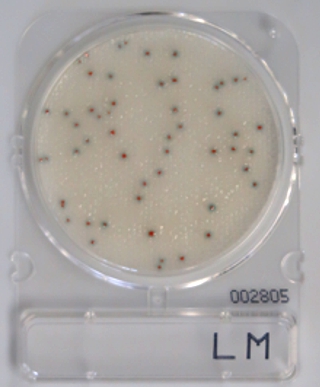Compact Dry LM
- Ready and easy to use portable plate: Preparation of medium is not required, which eliminates waste of medium as well as sterilizing apparatus to prepare the medium.
- Detection of colonies on plate is simple and clear.
- Single colonies on the plate can be isolated for further identification tests
Ready-to-use petri dishes for reliable microbiological analysis for Listeria Monocytogenes
Compact Dry LM is a ready-to-use, chromogenic plate for enumeration and detection of Listeria monocytogenes. A characteristic coloration on the medium of the Compact Dry Plate distinguishes colonies of Listeria monocytogenes from other Listeria species. These are pathogenic microorganism of the Listeria genus. They pose a particular risk to immunocompromised people. Listeria monocytogenes can survive at low refrigeration temperatures.
Incubation time and temperature: 30 ± 1 ℃ for 25 ± 1 hours
Shelf life: 18 months after manufacturing
Storage: At room temperature (1 - 30 °C)
Specimen preparation
Detection in solid foodstuffs, water or liquid foodstuffs
Add 9 times volume of half-Fraser broth to the sample and homogenize by Homogenizer. Incubate at 30 + 1°C for 25 + 1 hours for enrichment culture.
Detection in wiped sample
Add 9 times volume of half-Fraser broth to the wiping solution. Incubate at 30 + 1°C for 25 + 1 hours for enrichment culture.
Directions
Open aluminum pouch and take out a set of 4 plates.
Detach the quantity you need from a set of four by bending up and down while pressing the lid.
Take off the lid of the plate and drop 1 ml of a sterilized diluent (ex. saline) in the middle of a dry sheet to transform the whole of the sheet to gel.
Drop 0.1 mL of enrichment culture in the middle of the sheet. Streak the sheet with the inoculum from top to bottom by a loop softly and spread it over the whole of the sheet in order to get single colonies.
Turn over the capped plate after putting the lid again, and then incubate for 24 + 2 hours at 37 + 1°C. If colonies of presumptive L. monocytogenes are evident, the incubation may be stopped at this stage. If they are not evident, incubate for additional 24 + 2 hours at 37 + 1°C.
II. Operating Procedure for Enumeration
Preparation of specimen
Viable count in solid foodstuffs
Add 9 times volume of Buffered Peptone Water) to the sample and homogenize by Homogenizer. Pipette 1mL of homogenized specimen (to be further diluted if necessary) in the middle of a dry sheet of Compact Dry LM.
Viable count in water or liquid foodstuffs
Pipette 1mL of liquid sample (to be diluted if necessary) in the middle of a dry sheet of Compact Dry LM.
Viable count in wiped sample
Inoculate 1mL of wiping solution (to be diluted if necessary) in the middle of a dry sheet of Compact Dry LM. It is recommended to use Compact Dy swab
Directions
1. Open aluminum pouch and take out a set of 4 plates.
2. Detach the quantity you need from a set of four by bending up and down while pressing the lid. Use a set of four plates being connected when a series of diluted samples is inoculated.
3. Take off the lid of the plate and drop 1 ml of specimen in the middle of a dry sheet. Specimen diffuses automatically and evenly into all over the sheet (a medium size of 20 cm2) to transform it into gel.
4. Turn over the capped plate after putting the lid again, and then incubate for 24 + 2 hours at 37 + 1°C. If colonies of presumptive L. monocytogenes are evident, the incubation may be stopped at this stage. If they are not evident, incubate for additional 24 + 2 hours at 37 + 1°C
III. Precaution for use:
Precaution for Detection and Enumeration
1. During inoculation, do not touch the surface of medium and/or tip of dropper, and be careful to avoid any contamination by falling microorganism.
2. During incubation, keep lid tight of Compact Dry to avoid any possible dehydration.
3. It is recommended to use a stomacher bag with filter to eliminate risks of carry-over of tiny pieces of foodstuffs into the surface of the medium.
Precaution for Detection
1. During streaking, do not put strength into a loop and slip it softly on the surface of a sheet. A loop which has a large diameter and a smooth surface is suitable for streaking.
Precaution for Enumeration
2. Specimen should be diluted by buffer solution to the level of concentration of less than 300 cfu/plate.
3. If bacteria of more than 10 to 4 cfu are inoculated in a plate, no independent colonies are formed, and the whole medium gets stained.
4. If the nature of specimen does affect the result, the specimen should be inoculated only after the cause is eliminated by means of such as dilution and others. For example: specimens such as high viscosity, deep color, and too high or too low pH.
IV. Interpretation in Detection
1. Interpret red colonies with or without blue surrounds as presumptive positive for Listeria monocytogenes.
2. If a volume of L. monocytogenes is too much, no single colonies are formed and the whole of a sheet or the streaked part of a sheet looks red-colored. Interpret the result as presumptive positive in this case too.
V. Interpretation in Enumeration
1. Count red colonies with or without blue surrounds for presumptive L. monocytogenes.
Interpretation in Detection and Enumeration
2. If presumptive colonies of L. monocytogenes are observed, perform confirmation tests by ISO11290-1:2017, ISO11290-2:2017 or other methods.
Related Products
